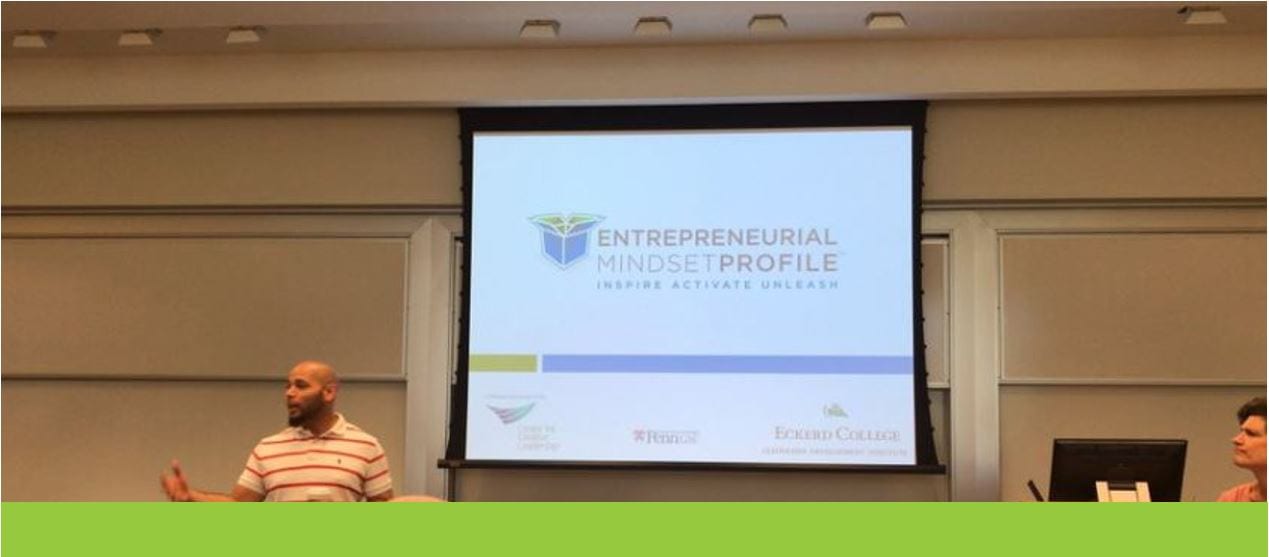Using the EMP at the University of Pennsylvania Graduate School of Education (GSE)
In a recent interview with the Leadership Development Institute at Eckerd College (LDI), Serrano Legrand, Jr., Entrepreneurial Educator and Doctoral candidate (Ed.D) at the University of Pennsylvania Graduate School of Education (GSE), explains how the Entrepreneurial Mindset Profile® (EMP) is being used to enhance entrepreneurial education in two different programs at the University of Pennsylvania.
LDI: Thank you, Serrano, for your work with the EMP at the University of Pennsylvania. Can you tell us about the two programs at GSE in which you’re using the instrument?
Legrand: I work closely with Dr. Bobbi Kurshan and Dr. Jenny Zapf, Founder and Director of the M.S.Ed. Education Entrepreneurship Program, respectively as well as with Dr. Michael Golden, Director of Catalyst, which is a center for global education innovation. Since we first began using the EMP close to five years ago, we have facilitated over a dozen plus EMP workshops that our PennGSE innovation team has delivered locally and internationally to hundreds of university and school leaders, edtech founders, researchers, business professionals and industry leaders. Our research really considers the EMP when it is situated within the education context. Obviously, education is a much more vulnerable space to operate in because of its close proximity to students, teachers and communities. In addition, we recently launched a 5-day Entrepreneurship in Education Global Certificate where the EMP is part of our core component of our curriculum. Finally, we hosted our first Entrepreneurial Mindset for Education Symposium, a multi-university and partner program that brought together 70+ educators and students. We partnered with Drexel’s Close School of Entrepreneurship and NFTE, a leading youth organization doing amazing work with Entrepreneurial Mindset.
LDI: How was the EMP helpful in the Catalyst program?
Legrand: With the Catalyst program, our goal is to connect people and ideas to develop new ways to advance education in novel and meaningful directions. This includes working with people across the education ecosystem: educators, school leaders, entrepreneurs, innovators, researchers and organizational leaders. The EMP gave participants a baseline for professional development and “a language” for thinking about other ways of being entrepreneurial. It also is a reflective tool for capitalizing on their strengths and building on other resources they may need to outsource. In addition, the instrument is a starting point for diving deeper into more meaningful dialogue. For instance, “What parts of an entrepreneurial mindset are we forgetting about in education?” or “What parts of entrepreneurial mindset could potentially be destructive?” Other questions which are interesting to explore are “Which scales do you feel you or your school have the most or which ones are aspirational?” Sometimes we talk about Risk Acceptance and the conditions which either promote it or stifle it…all deeply contextual through the lens of educators.
LDI: How is the M.S.Ed. Education Entrepreneurship Program designed?
Legrand: It is a 13-month, executive-style program made up of Masters students from an array of different experiences. Now in our 6th year, we invite a cohort of 35-45 students every year.
LDI: How do you use the EMP in this program?
Legrand: We use it towards the end of the Masters program. The students take the EMP and are immediately given their results so they can reflect individually about their scores. They then come to class where we go over some sample reports and have small-group discussions. Later we use the Group Report to look at the cohort as a whole, almost as if the cohort were an organization itself.
LDI: Are there any specific exercises or activities you use?
Legrand: We have the students stand up in different sections based on their strengths in the Personality and Skills scales. This exercise is really beneficial for two reasons: Not only does it help them build on their own strengths and leverage their classmates for future endeavors, but it also acts as a leadership development tool for going back to their own organizations and thinking about “who’s good at what” and what are we good at as an organization. It allows the students to see who is in the room and think about how all approaches together can make a better team. They all have a capstone project where they come up with a business targeting education so they use the EMP results to map out how they would resource this business.
LDI: How do the students respond to the EMP feedback?
Legrand: One thing we hear all the time is “Why didn’t we do this in the beginning?” They think it’s great and really like the visual of looking at different people and their stories and what it’s like living a particular strength in practice. They also think it’s a great team building activity because they really get to know each other from a different lens.
LDI: Are there any “Best Practices” you’d like to share for presenting or debriefing the EMP?
Legrand: We’ve found that asking the right questions and letting the students talk and do the “heavy lifting” is way better than having the facilitator do all the talking. Also, having the students work in small groups first before the class discussions is advantageous. It seems as if giving them time to engage with each other in the smaller groups allows them a space to be vulnerable, take risks, and kind of let go of any anxiety they might be feeling about sharing their scores. Then the larger-group discussions are more valuable. Also, making sure the students know the Development Guide is a great resource for them.
LDI: Thank you, Serrano, and we wish you all the best as you continue to use the EMP!
Interested in using the Entrepreneurial Mindset Profile® (EMP) with your students? Click here to learn about EMP Certification, email the EMP Product Manager at [email protected], or call 727-864-8241.


